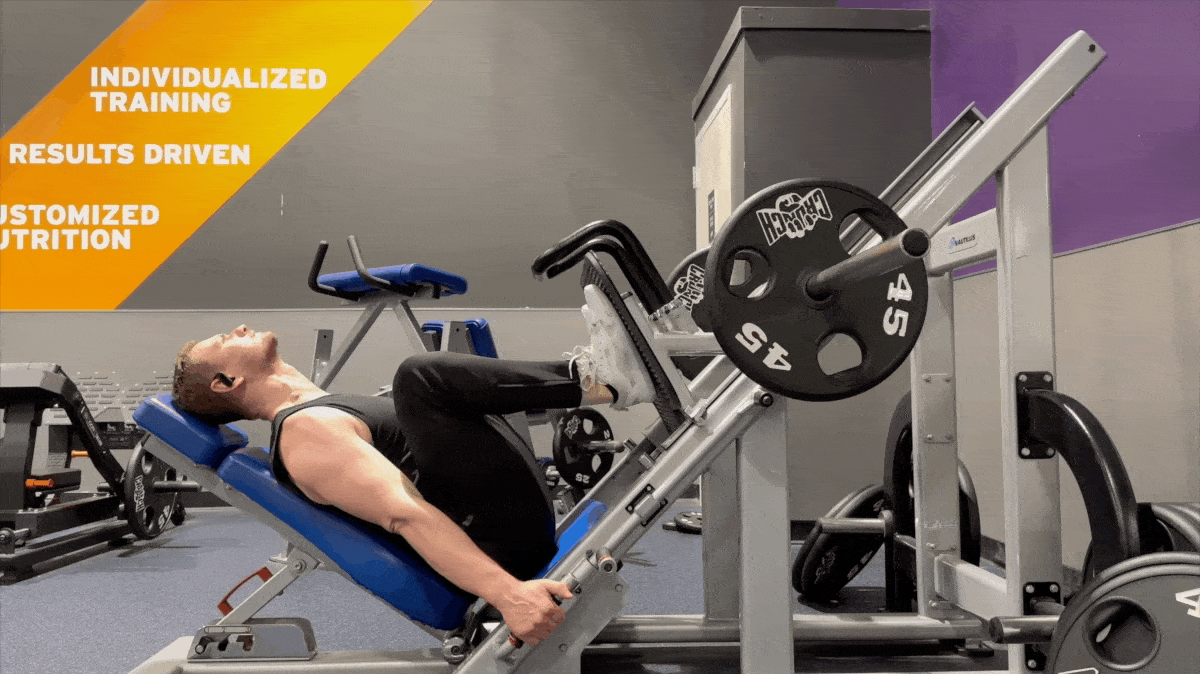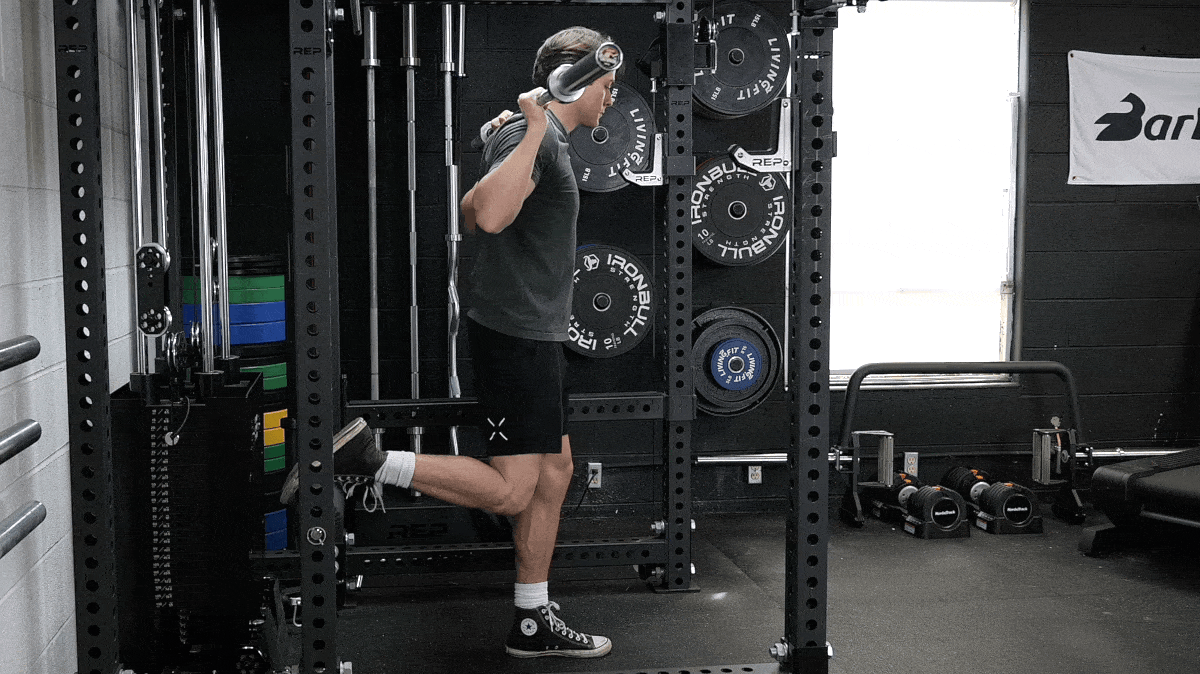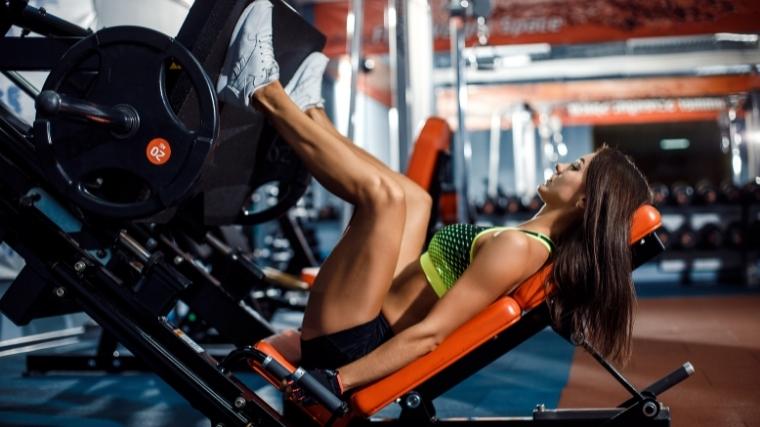The leg press is one of the best lower-body exercises out there. You’ll use a machine to help you drive quadriceps hypertrophy and improve squat strength. While the leg press is not a substitution for squatting, it can help beginners establish greater leg strength and growth. When you don’t want to add stress to your lower back but you need to give your legs an enormous challenge, the leg press comes in clutch. This powerhouse movement proves that the squat rack isn’t the only piece of equipment that can give you strong, well-developed legs.
Table of Contents
- How to Do the Leg Press
- Leg Press Variations
- Leg Press Alternatives
- Leg Press Sets and Reps
- Benefits of the Leg Press
- Muscle Worked by the Leg Press
- Who Should Do the Leg Press
- Common Leg Press Mistakes
- FAQs
Editor’s Note: The content on BarBend is meant to be informative in nature, but it should not be taken as medical advice. When starting a new training regimen and/or diet, it is always a good idea to consult a trusted medical professional. We are not a medical resource. The opinions and articles on this site are not intended for use as diagnosis, prevention, and/or treatment of health problems. They are not substitutes for consulting a qualified medical professional.
How to Do the Leg Press

- Step 1 — Sit into the seat and place your feet up against the sled plate in a comfortable, roughly hip-width stance.
- Step 2 — Unrack the weight sled using the handles by the sides of your hips. Once you have un-racked, bring your legs down into your chest and stomach so that your thighs break parallel and come as close to your body as possible.
- Step 3 — Once you have reached a full depth in the leg press, press your feet through the footplate and lift the sled upwards. Be sure to not lose tension in your hips and core, keeping your hips and lower back on the seat.
Leg Press Variations
The leg press machine isn’t a one-trick pony. You can use it for various types of leg presses, any of which can provide big value-adds to your program.
Banded Leg Press
- To perform the banded leg press, simply add a light resistance band to the leg press sled around the weight pegs and the seat frame.
- Perform your reps as usual.
1 ½ Leg Press
- To perform, lower the sled to the bottom position as usual.
- Press the sled halfway back up.
- Stop at the halfway mark, then lower it back to the bottom.
- Finally, push the sled back to the starting position. That is one rep.
Partial Leg Press
- To do a partial leg press, perform leg presses as usual, but only within a limited range of motion.
- This might mean staying within the top half of the rep (treating 90 degrees as the “bottom” of each rep instead of going all the way down). Alternatively, stay between the bottom of your range of motion and treat the 90-degree position as the “top” of each rep instead of going to full extension.
- Perform upwards of 15 reps per set to really overload your muscles here.
Leg Press Alternatives
Maybe the leg press machine is being used by someone who seems to be doing as many sets as humanly possible. Or maybe your gym doesn’t have a leg press machine at all. Don’t worry. You can still reap similar benefits to the leg press without a machine. You’ll just have to get a little creative.
Narrow-Stance Goblet Squat
- To perform the narrow-stance goblet squat, bring a dumbbell or kettlebell to chest height.
- Keep it tucked into your chest and your elbows close to your rib cage.
- Bring your feet to hip-width or closer.
- Sink back and down into a squat, keeping your torso as upright as possible.
Bulgarian Split Squat

- Place your back foot laces down behind you on a weight bench.
- Scoot your front foot out such that when you sink into a split squat, your front knee can reach 90 degrees and your back knee will point closely toward the ground.
- Perform your split squat while keeping your back foot raised behind you.
- Place the emphasis of the push on your front leg, driving your front foot into the ground.
Belt Squat
- To perform this movement, the lifter sets themself within a belt squat machine or hangs a load from their hips as they squat.
- Be sure to stand on platforms that allow you to assume a deep squat position without the load touching the floor.
- Whether you’re on a belt squat machine or using a squat rack or power rack to stabilize you, use your hands out in front of you to stabilize your movement.
Leg Press Sets and Reps
It’s easy to slap on some weight plates, sit down, unlock the safeties, and leg press without putting much thought into it. But if you’re really aiming to improve your leg strength and musculature with precision, you’ll want to have a more surgical approach to your set and rep scheme.
- To Gain Muscle: Perform three to five sets of 12 to 15 repetitions with a moderate to heavy load.
- To Increase Strength: Do three to six sets of eight to 10 reps with a heavy load.
- To Build Endurance: Perform three to four sets of 15 to 20 slow, controlled reps with light to moderate loads.
Benefits of the Leg Press
The squat might be the more glamorous of these two big lower-body lifts. But if you’re looking to develop big, strong quads, don’t sleep on the leg press. Here’s why.
Build Strength Post Injury
Check in with a doctor before diving back into training after an injury. But if you’ve been cleared for activity, the leg press can help ease you more safely return to strength training after time off.
It doesn’t take a lot of core stability, coordination, or exert a lot of pressure on your lower and upper back like a barbell squat does. You can start rebuilding your strength without other types of stress on your body.
Increase Quadriceps Development
Chasing teardrop quads? Need more powerful legs to fuel everything from box jumps to stronger squats? Whether your goal is aesthetics, strength, or both, the leg press is your new best accessory exercise.
Moves like the back squat and front squat rely on back and core strength in addition to leg strength to build up to maximum lifts. But the leg press allows lifters and athletes to attack the quadriceps without other muscle groups holding them back.
Minimize Direct Load in the Back
The leg press allows lifters to reduce loading on the spine yet still train the lower body. If you’re looking to dramatically increase your heavy leg volume while not putting stress on your back like a squat or a deadlift does, the leg press can get you there.
[Read More: The Best Home Gym Equipment, Tested and Verified by Experts]
Since your entire torso will be supported by the backrest and seat, you don’t have to worry about stabilizing your core and low back throughout the lift. And since you won’t be holding a loaded barbell in your hands (deadlift) or on your back (squat), your upper back gets a break, too.
Muscles Worked by the Leg Press
The leg press is a movement that targets the quadriceps. Your glutes and adductors will also get a fair amount of work, especially when you push this movement to its potential. The hamstrings, while slightly active in this movement, are much less involved than in a squat due to the limited amounts of hip flexion and extension while in the seated position.

The following muscles contribute to your success on the leg press, in general order of how active and engaged they are throughout each repetition:
- Quadriceps
- Glutes
- Adductors
- Hamstrings
Who Should Do the Leg Press?
There’s no way around it: the leg press simply isn’t a competition lift. But it would be all too easy for competitive strength athletes to dismiss the move as superfluous. While it’s not a strictly necessary move, this is a valuable accessory for many different types of athletes.
- Beginners: If you’re new to the gym, the leg press is ideal. It’s pretty self-explanatory, safe, and doesn’t require a lot of full-body strength and coordination. But it can get you plenty strong.
- Bodybuilders: Building the quadriceps and bringing them safely to absolute failure is a crucial component of lower body hypertrophy for physique athletes. The leg press is a powerful tool in that respect.
- Powerlifters and Strongman Athletes: Yes, powerlifters and strongwomen need to be highly skilled and strong with a barbell. And while the leg press isn’t a long-term substitution for these competitive lifts, it’s great for adding volume and intensity to leg day without eating too much into full-body recovery.
- Non-Competitive Gymgoers: There’s a middle ground between beginners and competitive strength athletes. The average, everyday gymgoer might be very interested in leg strength and hypertrophy, even if they’re not going to compete. Enter the leg press for providing exactly those types of gains.
[Read More: Squat Vs. Deadlift — Which Is Better for Strength, Mass, and Power?]
Common Leg Press Mistakes
Yes, the leg press can be one of the best leg exercises to add to your repertoire. But it’s only going to be as effective as you make it. Here’s what not to do when you’re taking this exercise for a proverbial spin.
Locking Out Your Knees
The idea behind a strong leg press is that you’ll be loading up pretty heavily. Without all that stress on your lower back that a barbell squat will inflict, this exercise gives you an amazing opportunity to move a lot of weight with minimal concern for your back.
[Read More: Best Weight Plates]
With all those weight plates angled above you, you do not want to lock out your knees between each rep. Doing so will place an undue amount of stress on your muscles and tendons. Instead of completely locking out your legs, straighten them until you reach a gently extended position. Don’t continue pressing and force them to totally lock.
You’ll still get the benefits without accumulating more risk. In fact, you’ll maintain more positive tension on your muscles by keeping your knees softly bent at the top.
Unintentional Partial Reps
Unless you’re deliberately performing partial reps to focus on a specific part of the lift, don’t skimp on your range of motion during the leg press. Stopping when your legs hit a 90-degree angle just won’t help you build muscle or increase strength as much as going as deep as you can with this movement.
Bring the tops of your thighs all the way down to your chest or stomach with each rep.
If you need more room to increase your range of motion than your chest or stomach allows, try widening your foot position slightly and actively push your knees outward to help get you deeper with each rep.
Knees Collapsing Inward
The first muscle group you think of with the leg press is probably your quads — and with good reason. But your glutes also provide a tremendous amount of power and strength with this movement.
Based on different limb lengths and other individual body factors, your knees might cave slightly inward naturally. And that’s okay. But if your knees are collapsing dramatically inward with each rep, it might indicate that your glutes are insufficiently engaged or just plain weaker than you want them to be.
Put your glutes in a good position to help you out by keeping your knees out or at least neutral.
Build Bigger Legs
For athletes chasing bigger, stronger legs, the leg press is a very valuable add-on to your program. You can load up this accessory movement with very heavy weight, making it an excellent choice when you want to overload your quadriceps. It’ll toast your glutes and adductors, too. And it will do all of this without all that added stress on your lower back and hips. Slide into a leg press machine today and watch your quads grow.
FAQs
Does the leg press work glutes?
Yes! Because each repetition of the leg press involves flexion at the hip joint in addition to the knee and ankle, you can expect to get some glute training in.
The deeper you’re able to flex your hip and the larger your range of motion is during the leg press, the more your glutes can contribute to the exercise.
How much should I leg press?
There’s no one-size-fits-all parameter to using the leg press, especially regarding how much weight you should work with. Most people tend to underestimate their potential, since it can be a bit scary to sit underneath a large, heavy sled.
The leg press comes with built-in failsafes to protect you from harm and allow you to load up with some serious weight. Working with heavier weights means more progress long-term, so don’t be afraid to really get after it on the leg press.
How much does a leg press weigh?
The amount that the sled plate itself weighs on the leg press varies by brand. However, without any weight at all added to the arms of the leg press, you’re still working with a little over 100 pounds on average.
Feature Image: SOK Studio / Shutterstock